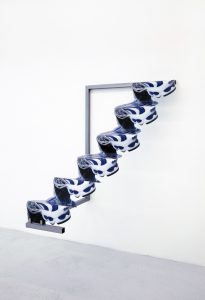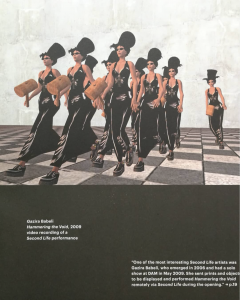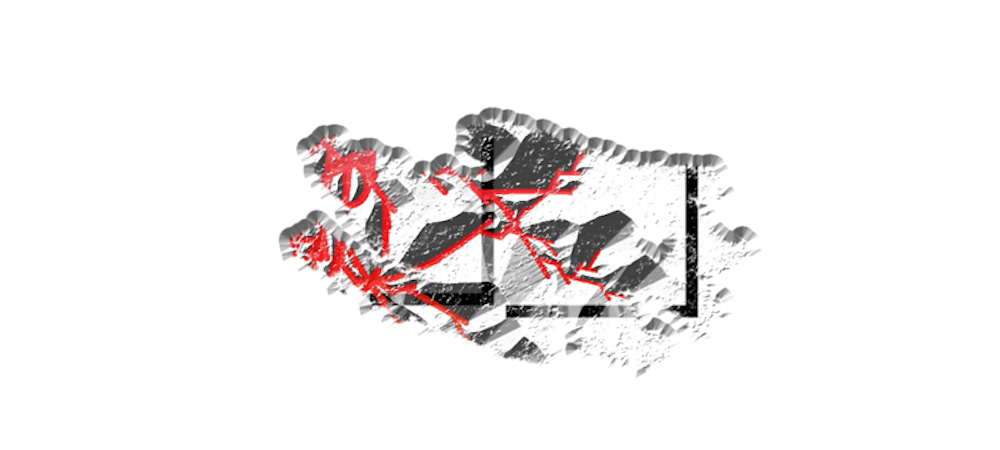STRIPTHƎSIS2023,.003 Many years ago, I used to have this ritual every time I went to my grandparents’ house to have lunch: not long after I had finished my meal, which was invariably divine, I would proceed to squeeze an espresso out of a simple machine placed right by the television set, standing below various family portraits. Along with this liquid delicacy, the grand highlight of my day, so far, I would treat myself to the pleasure of enjoying two pieces of dark chocolate with a high percentage of cocoa, oftentimes containing small, albeit far from insignificant, pieces of dried orange. This sensory symphony would proceed in the living room, where the bigger television set could be encountered. Among a variety of well-watered plants, I would find more portraits that, I assume, never went tired of being looked at.
Then, the show would commence. I would tune on to my favorite sports channel, timing it as closely as I could to the start of the 13:55 news. You see, the whole process had been so perfectly synced from the start that I would, on many of these occasions, to my prideful shame, sip that ridiculously strong espresso precisely as the sports news jingle would start to play, and even going as far as biting on the chocolate just as the newscaster regurgitated the initial wordings of some overseen piece of news. The whole ordeal would be perfectly wrapped by hypnotic shapes and circular drapes that every news program must contain, not to mention repetitive typical music, to capture the viewer’s subconscious by the groin.
Whenever I engaged in this activity, I would be aware of its occurrence, not fully understanding its significance, but certainly appreciating its spreading limbs all over my will. I’m sure I wanted to do this on every occasion, on some level, but I would mainly classify it as a need. The need for those palatable experiences to coincide with the visual aesthetics, as well as the aural information that would satisfy my cravings of staying up to date in the world of sports, even though most of the time I already knew the headlines by heart, from morning web developments.
If the main point would’ve been for me to stay informed, I would not even have cared about turning on the news, to begin with. I was very much aware of what had happened in the world of sports during the morning. I can even confess, rather pathetically, I did not pay much attention to the actual content that was on display, not at least after a few minutes of enjoying my delicious treats. I found family pictures and old books more intriguing. The spines of the books seemed to have been untouched for years as if the books were reluctant to be read and preferred to remain in a state of peaceful rest. Perhaps they were so engrossed in themselves that they fell into a deep sleep, hoping to avoid the pain of being forgotten on a shelf.

Not a major object would be changed on a daily basis — not a step would be ignored, not a flavour, a smell or even a temperature would oscillate further than the natural and predictable — which made me feel as if I was frozen in time. It’s as if I was realizing how precious the passage of time is, by experiencing a very specific chain of sensorial events, while not really feeling it going by, not quite understanding the change that was happening to me through my surroundings. I can still recall how this process allowed me to place myself deeper into my own inward meandering, asking very specific questions, not necessarily to get an instant answer, but rather to pursue newer questions, those I wouldn’t think of initially. Some people call this meditation, but I prefer to call it acclimation.
The response-driven actions I would take, to discover newer corners of my spirit that, up until then, had remained in the shadows, would consequently soak me in an honourable evolution, whether as a man, as a person or as a human whose mechanistic desires had long surpassed those of my innate being. At that moment, I finally comprehended the importance of this ritual and the delicate requirements it entailed. It was not just for show, it held a deeper significance that surpassed any selfish motives one may have had.
Vili Lähteenmäki provides us with an interesting view of the Orders of Consciousness and Forms of Reflexivity, specifically within Decartes’ frame of thought:
“Udo Thiel claims that Descartes draws no distinction between the meaning of ‘consciousness’ and ‘individual reflection’. His reading emphasizes that Descartes maintains a view of consciousness as achieved through thinking of thinking. As a result, his view winds up suggesting that for Descartes there are no other ways of acquiring experiential mental states, multifarious as they come. Even the simplest state of consciousness would then be achieved by considering one’s previous or simultaneous thoughts. Richard Aquila maintains a different view. He claims that Descartes’ notion of consciousness comes down to an idea of a single operation that is at once directed at itself and at an external object. Aquila argues that even if it would be correct that Descartes believes that we are conscious of external things by virtue of some second-order perception of the initial perception of the external object, this second perception must, nonetheless, be “somehow one with the first.”1

Thiel maintains that consciousness results from the subject’s explicit consideration of their thoughts, where the act of reflecting is a different thought from the thought reflected on, whereas Aquila contends that although two mental operations together comprised consciousness in some sense, these are not distinguished from each other by Descartes but rather identified as one. We could equate the action of understanding our situational reality to that of climbing a staircase that is forming itself in real-time. A new step appears, provided we offer the single leg motion that will propel us to climb further up. As if the fabric of the real deeply relies on your actions to be able to develop itself, through your perception. A new and intriguing question arises – can this outsourced process be used to fuel one’s artistic visions and deliver a more focused message?
Artists tend to review themselves in their work, eventually becoming part of the art they showcase. Sometimes the work and the artist are absolutely indissociable, turning the artist themselves into the masterpiece. In some more extravagant cases, like that of Gazira Babeli, the artist’s identity lies so far beyond the virtual embezzlement of reality that it’s impossible to determine where the person starts and their art begins. It’s actually impossible to determine who the person is! In his book, Domenico Quaranta describes her as the temporary form taken by an artist who has always obstinately stayed in the realm of nonvisibility but has managed to forge identities that are accepted and recognized by many as real.2 Gazira Babeli was extremely active between 2006 and 2010 (24 years in Second Life time, where one day is four hours long), participating in the work of the international troupe of performers Second Front, assisting with the operation of Odyssey, and even purchasing her own island, Locusolus, as a permanent residence for her creations. According to Quaranta, on February 26, 2010, she made her final entry into Second Life.

Hammering the Void, Gazira Babeli, 2009 (as featured in the supplement on DAM in Holo Magazine)
Do we need to comprehend our identity in order to create something of significant value? Does the public need to know the source of an artistic object so as to understand it fully? And how relevant to these developments is the space where all of this process happens? Heavy topics which are surely worthy of further discussion on future issues of STRIPTHƎSIS2023. We do know that, in the past, art was often seen as a reflection of the artist and their personal expression. Nowadays, I’m more inclined to define the artistic product through its audience and its social impact. According to Robert Porter:
“Deleuze and Guattari insist that the fabulating and deterritorializing function they generally attribute to the artwork should be approached in terms of what they call a ‘utopianism’ of the ‘now-here’, and that there is nothing elusive, dramatically heroic or other-worldly about the creation of a new form of political subjectivity.” 3
Painting and literature, for example, do more than just comment on or represent the real; they also participate in or even start, certain movements in the natural order of things. In my opinion, there is a deeper level of the psyche that stems from the crossing between the recognition of one’s existence and the fundamental need for selfish territorial anchoring, which in turn manifests through personal and individual rites. Your goal is to expand your knowledge base, but what if true innovation can only be achieved by utilizing the unknown fabric of reality as your building blocks? And if the immediate experience is extended in time; it flows, wherein time here does not refer to the discrete units of seconds, minutes, or hours; time, as apportioned into discrete units of time, is conceptual, not perceptual 4, it’s possible to affirm that you may never have time working to your benefit within the creative mental space, since immediate experience is a continuous flow of experiences that have duration rather than discrete events (Heft, 2002). You are permanently bludgeoned with an excessive amount of physical pleasure, mixed with just the right amount of spatial confusion, much before you can understand what is happening, or more importantly, why. And until you can happily place the what and the why within the correct whens, you’ll be lagging toward the creation of absolutely empty aesthetics. Visual chaos filled with shells within shells of plastic hope wrapped in hustler’s ambition.
As time flows by, almost unnoticeable, that ambition that you’re left with after that physical part of your journey is done and understood, is now being accoutered with newer rituals, primarily deriving from updated states of concern. What once was a necessity, almost by nature, has now been transformed into a set of outdated memories whose main function will be that of an archived supply for your psychological reflection. Or nostalgic dribbling. Some kind of limited edition shouting that will echo across rhythmix valleys of a certain sensitivity. Right then and there you will see yourself, as did I, repeating the same old rites in different circumstances, across different time frames, and you will feel they no longer contain that same need to exist. You might not have noticed, but newer personal dances with updated dimensions have now replaced the old ones. Both in importance and contentment, these new additions will desirably possess adequate levels for your optimal progression as an expander of the real while dealing with uncharted reality. It’s too bad you won’t notice it for quite a long time — but hey, just freeze time and smell the espresso! You won’t get another one like that any time soon.
———
1 Heinämaa, S., Lähteenmäki, V., & Remes, P. (2007). Consciousness : from perception to reflection in the history of philosophy. In Springer eBooks. pp 183-184.
2 Quaranta, D. (2016). Afk. Texts on Artists 2011-2016. p 45.
3 Porter, R. H. (2009). Deleuze and Guattari: Aesthetics and Politics. p 4.
4 Heft, H. (2002). Ecological psychology in context: James Gibson, Roger Barker, and the legacy of William James’s radical empiricism. Choice Reviews Online, 39(08), 39–4880. p 52.


